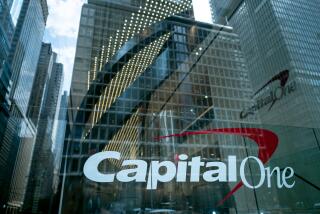Who wins in the City National bank sale
Royal Bank of Canada’s purchase of City National Corp., the priciest bank deal since the financial crisis, will create major expansion opportunities for the L.A. banking firm’s key businesses — wealth management, entertainment services, private and commercial banking.
But it was more than the $5.4-billion price that had the Goldsmith family, which owns a 13% stake in City National, agreeing to part with the bank when it wasn’t even for sale.
Here’s a look at some of the key factors:
------------
FOR THE RECORD:
City National sale: In the Jan. 27 Business section, an article about the benefits that City National Corp. expected from its sale to Royal Bank of Canada said that Canada was the second-biggest trading partner for the U.S. Canada is the largest trading partner for the U.S. The article also gave City National Chairman Russell Goldsmith’s age as 65; he is 64. —
------------
•340,000. That’s how many affluent U.S. households Royal Bank manages investments for, even though it has no branch in the United States. City National, by contrast, specializes in high-touch personal banking and business services to its wealth-management clients. “That’s going to give a tremendous opportunity to our bankers to reach out ... and give those clients additional alternatives,” said Russell D. Goldsmith, the chief executive.
•Two cities. Vancouver and Toronto, Canada’s major entertainment centers. City National, long known as L.A.’s “bank to the stars,” had already expanded into U.S. centers of entertainment, such as New York and Nashville. The RBC deal will make them the entertainment banks of choice for all North America, Goldsmith said.
•One. Britain, the only other English-speaking country with major entertainment activity. Goldsmith and Royal Bank CEO David I. McKay said they already are debating the name for a London branch, where Royal Bank has many clients and a charter to operate. The combined bank would provide private banking and wealth management along with entertainment services, as City National does in New York, where it is the No. 1 provider of support services for Broadway productions.
“That would certainly make City National the premier entertainment bank for the English-speaking world,” Goldsmith said.
After last week’s deal was announced, Goldsmith, 65, sought to reassure City National’s current customers that business would continue as usual. The deal did not require job cuts to make sense. Top executives including the president of the bank, Christopher J. Warmuth, 60, and chief credit officer Brian Fitzmaurice, 54, have agreed to stay on, Goldsmith said.
Goldsmith, whose family co-founded the bank in 1954, will also remain in his job for at least three years and head the banks’ combined wealth-management business in the United States.
With the backing of Royal Bank’s $800 billion in assets and AA credit rating — a strength endorsement equaled only by Wells Fargo & Co. among big U.S. banks — City National will be able to make and keep larger corporate loans. City National, with $32 billion in assets, can also now offer clients the ease of using RBC to do business in Canada, the United States’ second-biggest trading partner, Goldsmith said.
The merger also would allow City National to help corporate clients issue stocks and bonds for the first time, through Royal Bank’s large capital markets operation, Goldsmith said.
But City National’s competitors in Los Angeles and Orange counties hoped to lure away customers who prefer a locally owned bank.
“There always is some fallout [from bank acquisitions], and I think we’ll be the recipient of some of that,” said the chairman and chief executive of $5.5 billion in assets Farmers and Merchants Bank of Long Beach, Daniel K. Walker, who is part of the family that founded F&M in 1907.
City National emerged from the financial crisis in better shape than many banks, with a solid and enviable franchise. But it faced head winds in recent years that frustrated shareholders as low interest rates held back profits.
Goldsmith, who pulled down a $9.5-million compensation package in 2011, earned $4.3 million in 2012 and $3.9 million in 2013.
In early 2013, when Royal Bank first suggested a combination, about 20% of securities analysts following City National had a “buy” rating on the Los Angeles bank. Before the merger was announced, that had dropped to less than 10%, according to FactSet Research Systems.
Bank research firm SNL Financial said Monday that Royal Bank’s $5.4-billion cash-and-stock deal represents the highest premium above a large bank’s book value since another Canadian lender, Toronto-Dominion Bank, agreed to acquire Commerce Bancorp Inc. in New Jersey in 2007. The Goldsmith family will take its 13% share of City National Corp., about $700 million, entirely in Royal Bank stock, with the family restricted to selling no more than half of its holdings in the first three years.
Royal Bank shares declined from $62.12 before the deal was announced Thursday to close at $60.41 Monday. City National stock jumped 20%, from $74.57 to $89.45.
While some analysts questioned whether Royal Bank overpaid, Morningstar’s Stephen Ellis said the deal was supported by City National’s “trove” of cheap deposits that don’t pay interest — 62% of its total deposits — and the fact that most of its loans are adjustable and will yield more earnings if interest rates rise in an improving economy.
Wells Fargo’s analyst Jared Shaw also approved. He said City National’s wealth management was “a gem” that made the acquisition “very attractive” for the Canadian bank.
As for how City National made out, Shaw said the bank was “grabbing the brass ring.”
Twitter: @ScottReckard







